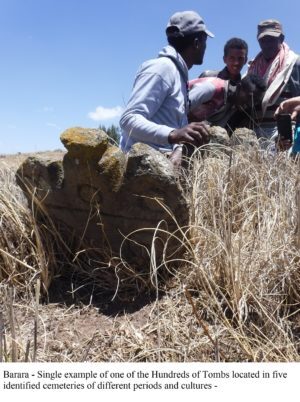
A team of archaeologists have identified the remains of what they suggest may be Barara, Ethiopia’s largest lost medieval city.
The city was thought to be a powerful center of trade and commerce during medieval times, and some medieval chroniclers identified Barara as the capital and governing seat of the legendary Prestor John, a Christian patriarch and king who was popular in European chronicles and tradition from the 7th through the 19th centuries. But after hundreds of years of prosperity, the city was thought to have been destroyed, possibly by the forces of Ahmad Gran the “left-handed” during the Religious Wars.
“Accounts of the destruction of Barara and other cities and churches accurately depict that demolition was total,” writes Samuel Walker, a lead archaeologist for the search, in his article recently published in Popular Archaeology. “Even grindstones were smashed to ensure populations had nothing to return to. During the religious wars, most associated religious structures, on both sides, along with their treasures of relics and manuscripts, perished, usually via fire.”
Walker and his team employed a variety of tools and approaches in their investigation, including historical documents research, interviews, mapping, remote sensing, and archaeological survey. Cooperating with Ethiopia’s government and community authorities, they were able to uncover or re-interpret already existing data, utilize remote sensing information, as well as geographic and material evidence on the ground, to draw conclusions with what they believe to be a high degree of confidence. The initial key to their research was intense study of a famous map of the world made around 1450 by the Italian cartographer Fra Mauro.
“The 1450 Fra Mauro map indicates that there are substantial medieval cities across Ethiopia [with] the largest, in the vicinity of Addis Ababa, called Barara,” wrote Walker in correspondence with Popular Archaeology. “Medieval Europe was mesmerized by the stories coming up from Africa into Jerusalem, and into Italy, Byzantium, and Alexandria, Egypt, the head of the Coptic Church. These cities were for centuries thought to be myth, but our research indicates that each of the geographical features can be identified and we now have candidates for every named city in Ethiopia at the time. This will substantially rewrite the history of Ethiopia and Africa as, for the first time, we have glimpses of various unknown civilizations across the landscape, in addition to putting evidence forth that these “myths” are in fact, substantial ruins with centuries of hidden history.”
Regarding Barara itself, Walker’s research led him and his team to a site that featured remains matching the characteristics that archaeologists would likely find for the medieval city. “Our initial assessment indicates the site covers more than 2 square kms, with large quantities of period-specific cultural material along with wheel-made and imported pottery sherds throughout,” Walker writes. “True occupational soils over a meter thick, large architectural features including foundations for towers, a water system 80 m across, five cemeteries identified thus far from different periods and cultures, one containing hundreds of tombs, prove this is a substantial site fitting all the criteria for a city the size and importance of Barara.”
Walker hopes that the new findings will open up more study and research on Ethiopia’s deep and complex history, shedding light on a region that has played a more significant role within the narrative of Old World civilization than previously realized or recognized in the popular literature.
Walker relates a more detailed account of the new discoveries in the article, Revealing Barara: The Long-Lost African Medieval City, a premium article published in the Spring 2019 issue of Popular Archaeology.
__________________________

Single-line 100 m field transect – Only diagnostics were collected and returned – Wheel-thrown and imported pottery, glass, and porcelain indicate outside influences and trade. Typical of an Imam Ahmed destruction, millstones and grinders have been shattered. Similar ceramic styles to early medieval vessels found at the Christian capital of Soba, Sudan (south of Khartoum) point to commerce and contacts.
__________________________

One of the hundreds of tombs identified among five cemeteries at the Barara site discovered thus far.
__________________________




One comment on “Archaeologists discover lost medieval city in Africa”